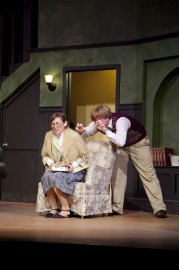Classic Murder Mystery Reimagined

By Marilyn Fernando
The Guardsman
In the darkness of the Diego Rivera Theater, the familiar childhood melody “Three Blind Mice” is feebly played on a piano, alluding to the sinister undertones of a snowed-in manor converted into a hotel.
City College’s production of Agatha Christie’s “The Mousetrap,” directed by Susan Jackson, is a suspenseful play that features an ending praised for its unexpected twist.
The simple and charming set design by Patrick Toebe features porcelain figurines and tin boxes that resemble standard grandmotherly décor. Antiqued jade green walls are trimmed with brown paint, and vintage furniture sits before a constantly lit door frame and a stairway leading to hotel rooms.
George Georges’ sound design and Jeffrey Kelly’s lighting design, meanwhile, explore the dark themes of “The Mousetrap.”
Act 1 begins with a staticky radio report of a nearby murder and ends with the sounds of a screaming murder victim muffled by the fast-paced, anxiety-inducing “Flight of the Bumblebees.” A hotel guest scuffles with the murderer in a silhouette cast in an eerie, dim hallway, leaving the audience as helpless in the dark as the character being murdered.
Newlyweds Molly and Giles Ralston, played by Angela Hernandez and Donny Goglio, use the radio to distract a variety of eccentric and secretive characters, including a mysterious foreigner, a retired major and an odd young man with hyperactive tendencies.
The pompous Englishwoman Mrs. Boyle, played by Rennee Christian, is a victim of over embellishment, while the hand-wringing, eye-darting, sweater-clad Christopher Wren, played by Andrew Sarran, is an energetic presence. An initial murder suspect, Wren’s prepubescent vocal range complements his gauche persona, making for an endearing character, like a lost child. But still, there is a murderer at large.
“Aside from the accent, he’s a lot like the regular me,” Sarran said.
Although playing the young and naïve Molly Ralston prematurely, Angela Hernandez exuded confidence through seamless, emotionally-charged line delivery. Her frightened and nervous expressions added complexity to an otherwise brash hotel manager.
Costume coordinators Sarah Moss and Tatiana Prue prepare a simple, tea-length charcoal dress that complement Ralston’s 1940s braided updo, which, according to Hernandez, help her “trigger emotional responses” and tones of voice.
“Getting the costumes together really helped me. There’s something about the costumes that solidifies who you are,” Hernandez said.

Hernandez and Goglio exude more chemistry than others, as when exchanging anniversary gifts at the play’s end. They behave like a real couple when kissing mouth-to-mouth.
Some actor’s performances were stronger than others, as it was apparent in some cases that nerves kicked in.
Mr. Paravicini, played by Honduran-accented student Luis Reyes, is difficult to understand. Reyes’ disconnect with the script, paired with a deadpan, unemotional delivery and lax body gestures, made him stand out for the wrong reasons.
Sergeant Trotter, played by Alex Araya, is heavily featured in the second act. A first- time performer, Araya’s strong performance stir emotions of confusion and delight. During the second act’s interrogation scene, it appears that Araya is shouting certain lines and failing to exercise emotional attachment to the script.
“I essentially turned all my emotions into anger, and that’s how I became Sergeant Trotter,” Araya said.
Christie’s murder mystery debuted on London’s West End in 1952 and is recognized as the longest continuously running play in the world. City College’s production concludes on Friday, Nov. 16 and Saturday, Nov. 17 in Ocean campus’ Diego Rivera Theater.
Follow Fernando on Twitter: @esornyliram

Comments are closed.